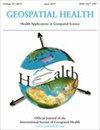中国西部地区公共卫生发展的方方面面。
IF 1
4区 医学
Q4 HEALTH CARE SCIENCES & SERVICES
引用次数: 0
摘要
一个国家的公共卫生水平与国家发展和生活质量密切相关。为了评价中国西部地区的卫生服务水平,我们使用了 2011 年至 2021 年 124 个地级单位的面板数据,以及基于生活质量、环境状况、卫生服务水平和寿命四个维度的健康评价指标体系。为了进行评估,我们使用了熵权重、标准差和变异系数,以及衡量分层空间异质性的地理检测器模型。结果表明,虽然公共卫生服务总体上有所改善,但各方面仍不平衡,因为各地的寿命并不一致。各健康维度的发展水平在西-中-东方向上呈现出相对平滑的梯度上升模式,而在北-中-南方向上的情况则较为不均衡,有升有降。然而,所有健康指标都呈现出持续增长的趋势,空间集群呈显著的正相关,热点和 "次热点 "由北向南收缩,而冷点和 "次冷点 "则由西向东扩展。这可以看作是多种因素共同作用的结果,其中城市化水平和经济水平是主导因素,政府引导、集聚能力和产业结构是辅助因素。本文章由计算机程序翻译,如有差异,请以英文原文为准。
Aspects of public health development in China's western region.
The public health level in a country is closely related to national development and quality of life. In order to appraise the level of health services in the western region of China, panel data of 124 prefecture-level units covering the period 2011 to 2021 was used together with a health evaluation index system based on four dimensions: quality of life, environmental situation, the level of health services and longevity. To assess this, we used entropy weights, standard deviation and coefficient of variation together with the geographical detector model that measures the stratified spatial heterogeneity. The results show that although public health services have improved overall, the various dimensions are still not balanced as longevity did not match up everywhere. While the developmental level of the various health dimensions presents a pattern of a relatively smooth increasing gradient in the west-central- east direction, the situation with respect to the north-centralsouth is more uneven with both ups and downs. However, a trend of continuous enhancement of all health dimensions was found with a significant positive correlation of spatial clustering, with hotspots and 'sub-hotspots' contracting from north to south, while coldspots and 'sub-coldspots' expanded from west to east. This can be seen as the result of multiple factors, with the level of urbanization and economic level as the dominant factors and government guidance, agglomeration capacity and industrial structure being auxiliary.
求助全文
通过发布文献求助,成功后即可免费获取论文全文。
去求助
来源期刊

Geospatial Health
医学-公共卫生、环境卫生与职业卫生
CiteScore
2.40
自引率
11.80%
发文量
48
审稿时长
12 months
期刊介绍:
The focus of the journal is on all aspects of the application of geographical information systems, remote sensing, global positioning systems, spatial statistics and other geospatial tools in human and veterinary health. The journal publishes two issues per year.
 求助内容:
求助内容: 应助结果提醒方式:
应助结果提醒方式:


